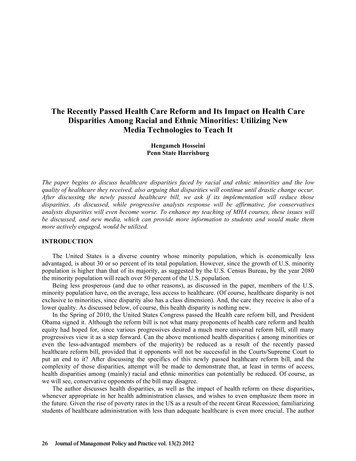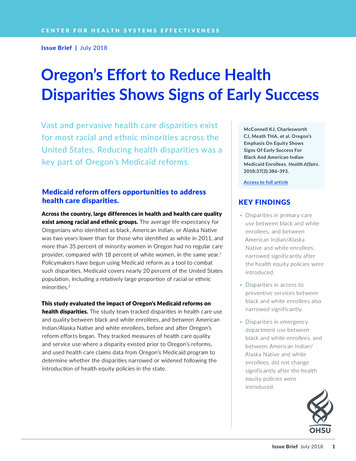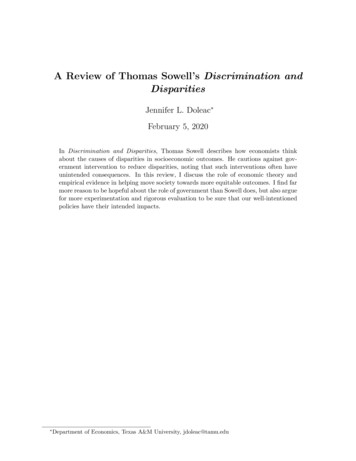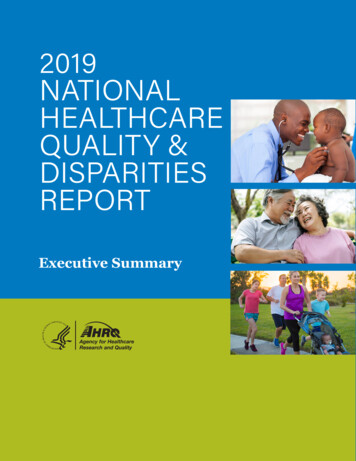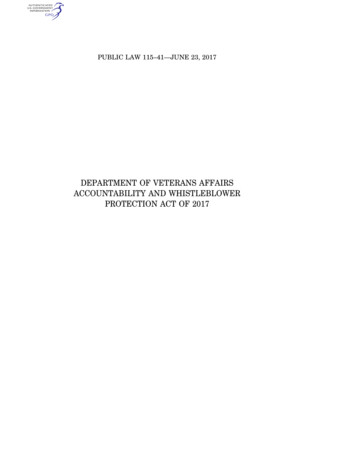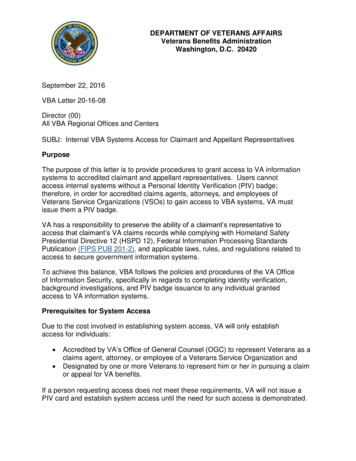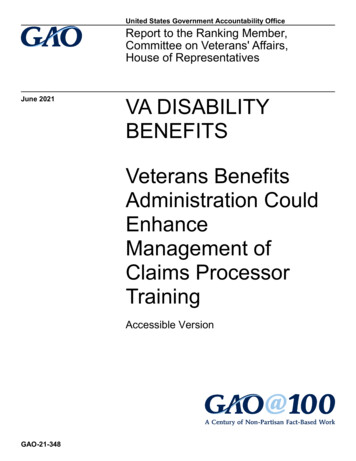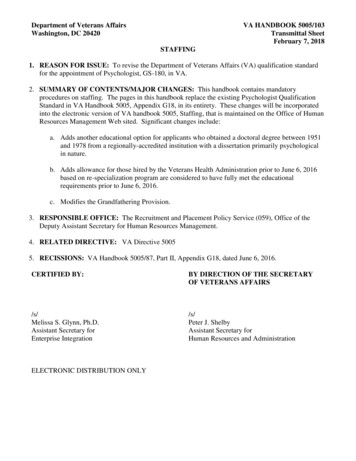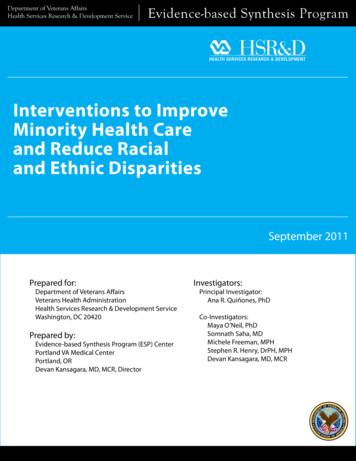
Transcription
Department of Veterans AffairsHealth Services Research & Development ServiceEvidence-based Synthesis ProgramInterventions to ImproveMinority Health Careand Reduce Racialand Ethnic DisparitiesSeptember 2011Prepared for:Department of Veterans AffairsVeterans Health AdministrationHealth Services Research & Development ServiceWashington, DC 20420Prepared by:Evidence-based Synthesis Program (ESP) CenterPortland VA Medical CenterPortland, ORDevan Kansagara, MD, MCR, DirectorInvestigators:Principal Investigator:Ana R. Quiñones, PhDCo-Investigators:Maya O’Neil, PhDSomnath Saha, MDMichele Freeman, MPHStephen R. Henry, DrPH, MPHDevan Kansagara, MD, MCR
Interventions to Improve Minority Health Care andReduce Racial and Ethnic DisparitiesEvidence-based Synthesis ProgramPREFACEHealth Services Research & Development Service’s (HSR&D) Evidence-based SynthesisProgram (ESP) was established to provide timely and accurate syntheses of targeted healthcaretopics of particular importance to Veterans Affairs (VA) managers and policymakers, as theywork to improve the health and healthcare of Veterans. The ESP disseminates these reportsthroughout the VA.HSR&D provides funding for four ESP Centers and each Center has an active VA affiliation. TheESP Centers generate evidence syntheses on important clinical practice topics, and these reportshelp: develop clinical policies informed by evidence,guide the implementation of effective services to improve patient outcomesand to support VA clinical practice guidelines and performance measures, andset the direction for future research to address gaps in clinical knowledge.In 2009, the ESP Coordinating Center was created to expand the capacity of HSR&D CentralOffice and the four ESP sites by developing and maintaining program processes. In addition,the Center established a Steering Committee comprised of HSR&D field-based investigators,VA Patient Care Services, Office of Quality and Performance, and Veterans Integrated ServiceNetworks (VISN) Clinical Management Officers. The Steering Committee provides programoversight, guides strategic planning, coordinates dissemination activities, and developscollaborations with VA leadership to identify new ESP topics of importance to Veterans and theVA healthcare system.Comments on this evidence report are welcome and can be sent to Nicole Floyd, ESPCoordinating Center Program Manager, at nicole.floyd@va.gov.Recommended citation: Quiñones AR, O’Neil M, Saha S, Freeman M, Henry S, Kansagara D.Interventions to Reduce Racial and Ethnic Disparities. VA-ESP Project #05-225; 2011This report is based on research conducted by the Evidence-based Synthesis Program(ESP) Center located at the Portland VA Medical Center, Portland OR funded by theDepartment of Veterans Affairs, Veterans Health Administration, Office of Researchand Development, Health Services Research and Development. The findings andconclusions in this document are those of the author(s) who are responsible for itscontents; the findings and conclusions do not necessarily represent the views of theDepartment of Veterans Affairs or the United States government. Therefore, no statementin this article should be construed as an official position of the Department of VeteransAffairs. No investigators have any affiliations or financial involvement (e.g., employment,consultancies, honoraria, stock ownership or options, expert testimony, grants or patentsreceived or pending, or royalties) that conflict with material presented in the report.ii
Interventions to Improve Minority Health Care andReduce Racial and Ethnic DisparitiesEvidence-based Synthesis ProgramTABLE OF CONTENTSEXECUTIVE SUMMARYBackground. 1Methods. 1Results. 2Summary of Findings. 2Discussion. 5INTRODUCTIONBackground. 8METHODSTopic Development. 9Search Strategy. 10Study Selection, Quality Assessment and Data Abstraction. 10Data Synthesis. 11Peer Review. 11RESULTSLiterature Search. 12Key Question #1. What is the state of research on interventions to reduce race/ethnic disparities or toimprove health and health care in minority populations within VA health care settings?. 13Key Question #2. What are the results of interventions (within and outside the VA) to reduce race/ethnicdisparities or to improve health and health care in minority populations?. 14Summary of Results across Interventions. 27DISCUSSIONState of Intervention Research. 28Conceptual Framework. 29Future Research and Implications for VA Health Care Settings. 31REFERENCES. 34FIGURESFigure 1.Figure 2.Literature Flow. 12Conceptual Model – Reach of Interventions. 31APPENDIX A. Search Strategy. 39APPENDIX B. Inclusion/Exclusion Criteria for Primary Studies and reviews. 41APPENDIX C. Quality Rating Criteria for reviews. . 43APPENDIX D. Evidence Table. 44APPENDIX E. Reviewer Comments and Responses. . 49iii
Interventions to Improve Minority Health Care andReduce Racial and Ethnic DisparitiesEvidence-based Synthesis ProgramEVIDENCE REPORTINTRODUCTIONBACKGROUNDRacial and ethnic disparities are widespread in the US health care system. A 2007 reportfrom the Portland Evidence-based Synthesis Program (ESP) similarly found disparities wereprevalent in a variety of clinical arenas within Department of Veterans Affairs (VA). The reportidentified several promising avenues for future interventions designed to reduce racial andethnic disparities. The extent to which such intervention research has been conducted in VApopulations is unclear, though our review of published studies suggests disparities interventionresearch in the VA may be lagging behind research of interventions conducted outside of the VAsetting. Furthermore, the approach to disparities interventions may be quite varied, and this mayfurther complicate the development of an organized research agenda within the VA. Identifyingchallenges to conducting intervention research remain critical steps to informing future VAdisparities intervention efforts to reduce disparities and improve health outcomes for minorityVeterans.The objectives of this review are to describe the state of disparities intervention research withinthe VA, glean lessons from systematic reviews of intervention research not limited to VA settings,and develop an organizing framework to describe studies in this field of research. This work isprimarily intended for the Equity Portfolio for the VA Health Services Research & Development(HSR&D), the Veterans Health Administration (VHA) Health System Leadership and the field ofrace/ethnic disparities researchers, for the purposes of informing future disparities interventionresearch in the VA as well as VA policies and programs to reduce disparities.Return to Contents8
Interventions to Improve Minority Health Care andReduce Racial and Ethnic DisparitiesEvidence-based Synthesis ProgramMETHODSTOPIC DEVELOPMENTThe review was requested by the director for the Equity Portfolio of the VA HSR&D andcommissioned by the Department of Veterans Affairs Evidence-based Synthesis Program.We relied on individual topic expertise to form the technical expert panel for guiding topicdevelopment and reviewing drafts of the report. The objective of this report is to review theevidence that addresses the following key questions:Key Question #1. What is the state of research on interventions to reduce race/ethnic disparitiesor to improve health and health care in minority populations within VA health care settings?Key Question #2. What are the results of interventions (within and outside the VA) to reducerace/ethnic disparities or to improve health and health care in minority populations?We used the following methods to address these questions:1) Primary literature review of studies with the following characteristics: Patients: any VA patient populationIntervention: any intervention primarily designed to reduce disparities or improvequality of care or outcomes for minority populationsComparator: studies comparing minority to non-minority Veterans as well as studiesfocusing on outcomes for a targeted minority group of VeteransOutcomes: no intention to limit by outcomeTiming: any length of follow-upSetting: VA, inpatient or outpatient2) Review of systematic reviews and meta-analyses of race/ethnic disparities interventionsconducted in VA and non-VA settings.In addition, discuss the utility of categorizing existing disparities research according to the kindsof populations included in the studies as well as by intervention type to provide an organizinglanguage for the interventions literature. Two categories to describe included study populations:oSingle-race or minority-only populations: examined the effect of interventionswithin a group known to receive lower quality care, or have poorer outcomes,than the majority white population. Effectiveness documented in such studiesprovides only indirect evidence that the studied intervention will reducedisparities.oComparative: included both minority and majority populations and comparemeasures in both groups before and after the intervention. Such studies providedirect evidence of an intervention’s capacity to reduce disparities. Two categories for intervention types:oGeneric interventions: applied without consideration of group specific needs or9Return to Contents
Interventions to Improve Minority Health Care andReduce Racial and Ethnic DisparitiesoEvidence-based Synthesis Programpreferences. Many of these interventions involved quality improvement effortsor care standardization testing the premise that deficits in care for minoritygroups might be reduced if care was applied similarly for everyone.Tailored interventions: described efforts to address barriers specific to a minoritygroup. Many of these interventions involved specially designed educationalmaterials crafted with specific minority groups in mind (e.g., lessons that addressknowledge and health beliefs of minority populations), or community healthworkers that addressed the special needs of minority patients within their owncommunities. Community health workers were typically members of thoseminority communities and therefore understood the context and culture of thepopulation served.SEARCH STRATEGYWe conducted a search for recent primary intervention studies of VA patients in MEDLINE (PubMed ) (2006 through August 2010) using the search strategy developed for the 2007VA ESP report on health disparities (Appendix A). We also conducted a follow-up search forrecently published studies by investigators identified in the 2007 report because they wereconducting pending intervention work at the time of that report. Finally, we conducted a searchfor systematic reviews of intervention studies that are not limited to VA patients in MEDLINE (PubMed ), the Cochrane Database of Systematic Reviews (OVID), and PsycINFO (OVID)(database inception through November 2010). We obtained additional articles from referencelists of pertinent studies, and through reviewer feedback following review of the initial draft ofthis report. All citations were imported into an electronic database (EndNote X2).STUDY SELECTION, QUALITY ASSESSMENT, AND DATAABSTRACTIONTwo reviewers assessed the titles and abstracts identified by the literature search for relevanceto the key questions. Potentially relevant full-text articles were retrieved for further review.Two reviewers independently reviewed the articles for inclusion, and discordant results wereresolved through discussion and input from a third reviewer. We included individual studiesevaluating the effects of an intervention within or between racial/ethnic groups in VA patients.We relied on systematic reviews and meta-analyses of intervention studies conducted outsidethe VA setting (inclusion/exclusion criteria provided in Appendix B). We excluded poor qualityreviews as defined by previously developed criteria (Appendix C). We also excluded reviewsof interventions that were not likely to be applicable to VA settings (i.e., studies focused onreducing financial barriers to access).From each study, we abstracted information on clinical topic, study methodology, populationcharacteristics including race/ethnicity, types of interventions studied, search dates and numberof studies included for systematic reviews.We dual-reviewed each study for quality and data abstraction. Disagreements were resolvedthrough discussion, and a third investigator was consulted when needed to reach consensus.10Return to Contents
Interventions to Improve Minority Health Care andReduce Racial and Ethnic DisparitiesEvidence-based Synthesis ProgramData synthesisWe examined intervention studies of both primary studies of VA populations, and systematicreviews conducted in settings not limited to the VA. We organized the literature addressing keyquestion #1 and key question #2 according to clinical or substantive topic area in the Resultssection including: diabetes mellitus, arthritis and pain management, preventive and ambulatorycare, cardiovascular disease, human immunodeficiency virus/auto immune deficiency syndrome(HIV/AIDS), mental health, and cross-cutting interventions.We developed an abstraction form in order to extract data from included primary studies andsystematic reviews. Our syntheses of systematic reviews were qualitative in nature. Becausewe engaged in reviews of systematic reviews, we relied on the conclusions and syntheses fromreview authors to a large extent. We gave higher consideration to reviews of good quality, asdetermined by the quality criteria detailed in Appendix C.Peer reviewA draft version of this report was sent to the technical expert panel and additional peer reviewers.Their comments and our responses are included in Appendix E.Return to Contents11
Interventions to Improve Minority Health Care andReduce Racial and Ethnic DisparitiesEvidence-based Synthesis ProgramRESULTSLITERATURE SEARCHThe search for systematic reviews and meta-analyses yielded 2,127 citations, and the search forprimary VA studies published since the 2007 report yielded 1,290 citations. Appendix B detailsthe inclusion/exclusion criteria for study selection. Following a review of these 3,417 titles andabstracts, we selected 115 articles for further review at the full-text level. Of these, we includedfive primary VA studies and 34 systematic reviews across the various clinical areas (Figure 1).The table in Appendix D provides details about the included studies. We discuss the results bykey question in the sections that follow.Figure 1. Literature FlowAbstracts imported from MEDLINE, Cochranedatabase. (1950-July 2010)SR search N 2127Search for recently published primary studiesconducted in VA settingsN 1290Total articles retrieved for fulltext reviewN 120Primary studieswithin VAN 5Diabetes (n 1)Mental health (n 2)Arthritis/pain (n 1)Cross-cutting (n 1)Total excluded articles 86Non-English language (n 2)Study population not US adults (n 4)Study did not evaluate an intervention,or subjects did not include a racial/ethnic minority subgroup (n 36)Did not meet methodological or qualitycriteria for SRs (n 36)Used for contextual purposes only (n 8)Systematic reviewsN 34Diabetes (n 5)Arthritis and pain management (n 1)Preventive and ambulatory care (n 14)Cardiovascular disease (n 3)HIV/AIDS (n 4)Mental health (n 2)Cross-cutting (n 5)12Return to Contents
Interventions to Improve Minority Health Care andReduce Racial and Ethnic DisparitiesEvidence-based Synthesis ProgramKEY QUESTION #1. What is the state of research on interventions toreduce race/ethnic disparities or to improve health and health care inminority populations within VA health care settings?We found five recently published primary studies of interventions involving minority Veteranpopulations.1-5 The populations included in these studies varied. Two were comparative andincluded black and white Veterans.1, 5 Another two studies were comparative with black, whiteand Hispanic Veteran populations.2, 4 The final study was single-race and examined NativeAmerican Veterans.3The effectiveness of the interventions examined by these studies also varied. Only one of thestudies examined is able to conclude that the intervention significantly reduced disparities.4 Oneof the studies did not examine the effects of the intervention by race group,1 one study piloted theacceptability of the intervention in the minority population without evaluating the effects on theoutcome,3 one study found reductions in disparities in intermediate outcomes only5 and the finalstudy concluded that no significant findings were attributable to the intervention.2The single-race study compared videoconferencing with in-person administration of a psychiatricassessment among American Indian Vietnam Veterans.3 Although this study was unable todetermine whether the intervention was effective in improving psychiatric outcomes for NativeAmerican Veterans, it concluded that teleconferencing was a culturally acceptable methodfor the delivery of psychiatric care for this sample of minority Veterans. Similarly, one of thecomparative studies investigating the effectiveness of a screen-phone assisted care coordinationfor black, white and Hispanic Veterans with dementia was unable to determine whether theintervention reduced disparities.2 The study concluded that there were no significant findings. Aseparate comparative study of black, white and Hispanic Veterans by the same author examinedthe effects of a phone-based, in-home messaging device combined with care coordination onglycemic control among diabetics.4 This study was able to conclude that disparities in glycemiccontrol were reduced between white and black Veterans. The fourth study was a comparativestudy between black and white Veterans that examined the effects of an educational videotapeand tailored total knee replacement decision aid on patients’ expectations about postoperativepain, physical function, and willingness to consider total knee replacement surgery.5 Thisstudy found decreased disparities between black and white Veterans in intermediate outcomes(knowledge and expectations) rather than in osteoarthritis outcomes. The fifth study was acomparative study between black and white Veterans.1 The study examined found that theintervention was effective in reducing hospital admissions and total days hospitalized for thestudy sample, but did not examine the results of the intervention by race.We discuss the results of each of these primary VA intervention studies in combination with thefindings of systematic reviews on similar clinical/substantive topics to key question #2 in thesections that follow.13Return to Contents
Interventions to Improve Minority Health Care andReduce Racial and Ethnic DisparitiesEvidence-based Synthesis ProgramKEY QUESTION #2. What are the results of interventions (within andoutside the VA) to reduce racial/ethnic disparities or to improve healthand health care in minority populations?Diabetes InterventionsSummaryFive good quality systematic reviews of interventions for diabetes mellitus identified studiesthat were mostly conducted in single-race populations. The outcomes studied included glycemiccontrol measures, patient knowledge and satisfaction, dietary habits, physical activity, selfmanagement activities, emergency room visits and hospital admissions. Process measuresincluded the use of eye exams, microalbumin testing, HbA1c monitoring, foot care, and exercisecounseling. We identified a primary intervention study tested on a multiethnic populationof Veterans that examined the effects of care coordination and telemedicine intervention onglycemic control. We also reviewed a randomized controlled trial of the effects of culturalcompetency training on both clinician awareness and glycemic control among black and whiteoutpatients. There was some evidence of benefit for interventions focused on community healthworkers, care managers, and culturally tailored health education for patients. Provider-focusedinterventions reported improvements in process measures, although computerized remindersfor physicians resulted in negligible or negative results. Studies on the long-term effects ofdiabetes mellitus interventions on process and outcome measures are lacking. Heterogeneitybetween studies in subjects, settings, study design, and multiple aspects of the interventionslimit the comparisons that can be made across studies. One small single center VA studysuggests a telemedicine/care coordination intervention may reduce disparities in black Veteranswith diabetes; this finding warrants further research. A study of cultural competency trainingsignificantly increased clinician awareness of racial differences in diabetes care, but no effectwas observed on reducing disparities between white and black patients on glycemic controltargets, LDL cholesterol, or blood pressure 12 months after the intervention.DetailsWe identified five good-quality systematic reviews of interventions for diabetes mellitus,6-11including a Cochrane review7 that was subsequently published as a journal article.6 We foundone primary intervention study conducted in VA settings that examined race/ethnic disparities fordiabetic Veterans.The interventions identified by existing reviews included health education interventions;6, 7 theuse of community health workers;10 primary care interventions (including case management,patient counseling, and the use of reminder cards for providers);9 and self-care interventionsaimed to change behavior using culturally tailored techniques.11 One review included a variety ofinterventions including patient-targeted interventions, physician provider-targeted interventions,health care organization interventions (including case management, community health workers,and pharmacist-led medication management), and multi-target interventions.8 Most of the studiesidentified by the systematic reviews were conducted in single-race populations.A review of health education interventions determined that culturally tailored health education wasmore effective than usual care in improving HbA1c and knowledge for up to one year of follow-up,although clinically important long-term outcomes were not examined.6, 7 Another review of health14Return to Contents
Interventions to Improve Minority Health Care andReduce Racial and Ethnic DisparitiesEvidence-based Synthesis Programeducation interventions that sought to improve dietary habits, physical activity, or self-managementactivities reported that using interpersonal interventions such as peer support and nurses/nutritionists/health educators more often had positive findings than computer-based patient education.8One review examined self-care interventions that aimed to change the behavior of patients,rather than simply educating them. Four of the 12 included studies were designed using culturaltailoring techniques such as the use of focus groups and specific recipes for the ethnic groupbeing studied. Improved glycemic control tended to occur in studies in which baseline glycemiccontrol was markedly poor (A1C 10%). The author of the review concluded that culturallytailored interventions appeared to be successful among African Americans and Latinos, and thatself-care interventions may be effective in more difficult-to-treat patients.11One review examined five provider-focused interventions (reminder systems, practice guidelines,continuing medical education, in-person feedback, and problem-based learning) and reportedimprovements in process measures such as the use of eye exams, microalbumin testing,HbA1c monitoring, foot care, and exercise counseling. By contrast, computerized remindersfor physicians resulted in negligible or negative results. None of the physician-targeted studiesincluded provider communication, cultural competence, or shared decision making.8Interventions that used community health workers, care managers, and other non-physicianproviders showed evidence of benefit, although comparisons across studies were limited bythe heterogeneity in the interventions, settings, and types of providers. A review of health careorganization interventions found that nurse care managers were effective in improving quality ofcare as well as patient outcomes, including diabetes control and onset of retinopathy. Telemedicinecase management had more modest results than on-site nursing staff. Positive findings were foundfor other non-physician interventions, including the use of community health workers and medicalassistance programs that provided free medications.8 A review of case management delivered byspecialist nurses found improvement in glycemic control and cardiovascular disease risk factorsincluding blood pressure and total cholesterol.9 A review of community health workers serving ina variety of roles showed some improvements in patient knowledge, behavior and satisfaction, anddecreases in emergency room visits and hospital admissions; increases in retinopathy screening andglycemic control monitoring by providers were also noted in a few studies.10A primary study conducted at an urban VA Medical Center (VAMC) examined the effects ofa care coordination and telemedicine intervention on glycemic control among older Veterandiabetics.4 Patients aged 60 and older (mean age 72 years SD 6) were enrolled for at least ninemonths. Although the study population was small (n 41), it did recruit black (n 14; 34%),white (n 21; 51%) and Hispanic (n 6; 15%) Veterans. The study was designed as a pre-postintervention evaluation. Patients used a telephone-based, in-home messaging device to transmitblood sugar data and answers to clinical questions to the care coordination team, comprised of anurse practitioner, social worker, administrative assistant, and geriatrician. The data were used toboth risk stratify patients and guide ongoing clinical advice from the care coordination team. Acomparison of pre- and post-intervention data found that glycemic control improved significantlyin black, but not in white or Hispanic Veterans. However, several methodological issues limit thevalidity of study findings including the single-site observational design and high attrition rate (28originally eligible Veterans did not complete the study).15Return to Contents
Interventions to Improve Minority Health Care andReduce Racial and Ethnic DisparitiesEvidence-based Synthesis ProgramArthritis and Pain Management InterventionsSummaryOne fair quality systematic review of behavioral interventions for arthritis in racial and ethnicminority populations found limited evidence from a single randomized controlled trial thatexercise interventions may be effective in improving pain and disability. Compared with ahealth education control program, exercise programs were comparably effective betweenwhites and African Americans in improving pain and disability. In addition, one primary VAstudy investigating an educational intervention provides evidence of improving knowledgeand expectations related to total knee replacement; however, it does not improve willingness toconsider total knee replacement surgery.DetailsA fair-quality systematic review12 that included 25 rando
Program (ESP) was established to provide timely and accurate syntheses of targeted healthcare topics of particular importance to Veterans Affairs (VA) managers and policymakers, as they . Center located at the Portland VA Medical Center, Portland OR funded by the Department of Veterans Affairs, Veterans Health Administration, Office of .
